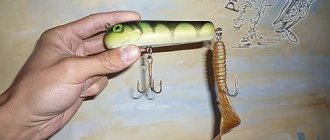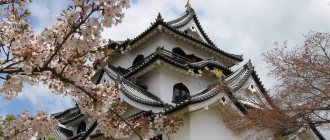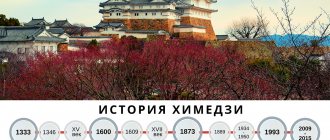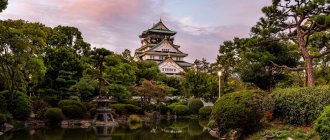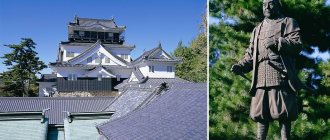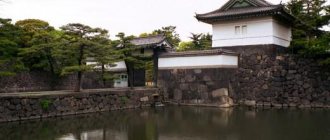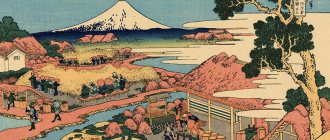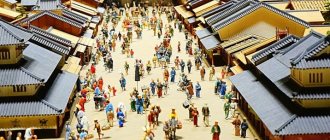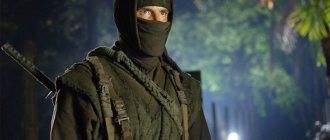general information
The city of Osaka ranks third in Japan in terms of population (2.7 million people). The samurai castle, located there and built more than 400 years ago, played a significant role in the history of Japan in the 16th-17th centuries, withstanding a difficult siege by a huge army.
It is also important to note that 30 thousand people simultaneously participated in its construction.
Osaka Castle address: Japan 540-0002, Ōsaka-fu, Ōsaka-shi, Chūō-ku, Ōsakajō, 1.
INUYAMA CASTLE
Age : the first castle was built here back in 1440, the current castle is from the 16th century (built in 1537).
Feature : considered by many experts to be the most authentic Japanese castle. The only castle in Japan that was privately owned until 2004.
Erected on the banks of the Kiso River, Inuyama Castle has survived many wars and natural disasters, however, almost completely preserved from the 16th century. From 1895 to 2004 it was privately owned by a Japanese family, who carefully maintained it in excellent condition. It is now one of Japan's 12 surviving medieval castles.
The territory of the castle itself and around it is especially picturesque in the spring, during the cherry blossom period, and during the “red maple” period - in the fall. From the top floor of the castle tower you can take breathtaking photos of the Kiso River valley: in April the entire area is covered in pink flashes of cherry blossoms, and in November it is colored in dark red, yellow and orange.
Around the castle you can find several small beautiful temples. We advise you to go to the Sanko Inari Temple - it is beautiful in itself, and in addition, it is known among the Japanese as a place where people with stories of unhappy love come to ask for a life partner.
At the beginning of April, Inuyama Castle hosts the paper lantern festival of the same name, when thousands of these man-made fireflies float along the river - a breathtaking sight, we recommend visiting the castle at this time (especially since in April sakura also blooms around the castle).
How to get there . First you need to arrive at Nagoya Station (52 minutes from Osaka or 1 hour 40 minutes from Tokyo). From Nagoya, take the Meitetsu Line and get off at Inuyama or Inuyama-yuen Station. The castle is a 20 minute walk from both stations.
Inuyama Station can also be reached by regular buses from Tokyo (Shinjuku Station), Kyoto, Osaka, Nagoya.
Brief history of construction
The castle was built in 1583 by the commander Toyotomi Hideyoshi, with the aim of establishing a new center of Japan, united during the reign of the Toyotomi clan. However, these intentions were not destined to come true, since in 1615 a fierce battle took place with the Tokugawa clan. The castle withstood this siege (Tokugawa Ieyasu's army numbered 2,000 people).
Although the fortress was not taken, the enemies managed to fill up the ditches surrounding it, which were an important element of the fortification system of Osaka. The next year, Hideyori (Hideyoshi's son) tried to rebuild the outer moat and fill it with water, but the enraged Tokugawa and his warriors captured the castle. Hideeri and his mother committed suicide and today a memorial sign has been erected at the site of their death.
The new ruler rebuilt and expanded the castle, but lightning that struck the main tower in 1665 led to a fire that destroyed almost everything. After restoration, the castle burned again in 1868, during the events of the Meiji Restoration. By the beginning of the 20th century, almost only ruins remained of the castle, and the surviving premises were barracks.
It should be noted that the castle in Osaka (photo presented in the article) was originally built on the model of the Azuchi Castle previously built by the military-political leader Oda Nobunaga.
The last floor of the castle in Osaka...
"Winter Campaign"
After the publication of material about the Battle of Sekigahara and the current state of the castle in Osaka, many wanted to know how it all ended there? Well, yes, three years after the battle, Tokugawa Ieyasu became shogun, that is, he received the highest post in the state after the emperor, which had been vacant since the commander Oda Nabunaga thirty years before all these events ended the shogunate of Ashikaga Yoshiaki. Kobayakawa Hideaki, the main Japanese traitor in history, also got everything he wanted, but two years later it is unclear why (or maybe it’s just understandable?!) He went crazy and... died.
Ishida Mitsunari, the leader of the “Westerners,” had his neck sawed off with a bamboo saw, but Toyotomi Hideyori, Hideyoshi’s son, was still considered his father’s heir, and his family remained the richest and most influential in Japan. Moreover, many princes believed that the new shogunate was nothing more than a temporary phenomenon. In addition, Hideyori had his youth on his side, and Tokugawa had his old age against him. True, Ieyasu had sons and, above all, the eldest son Hidetada. He could leave the title of shogun to him. But Hideyori in this case became kwampaku - chancellor, and the situation of confrontation between “West” and “East” could repeat itself again! And if anyone understood this better than others, it was Tokugawa Ieyasu himself. He understood, but did not try to force things. Another, having received power, would immediately start lining his pockets, executing enemies and pardoning friends, and this would be clear to everyone. But Ieyasu was not like that!
Toyotomi Hideyori. Osaka Castle Museum.
“Slowness is the property of the devil,” says the old Spanish proverb, and it should be noted that Ieyasu, more than anyone else, knew how to “hurry slowly.” And he began by trying to lull Toyotomi’s vigilance, for which he married Hideyori, a man whom he hated and dreamed of destroying, to his own granddaughter and through this became related to him! After that, he decided to ruin it and did it in a very original way: by inviting each daimyo to build himself a new castle! Everyone bought into this, including Toyotomi, but even after completely rebuilding the castle in Osaka, their clan did not become poorer, although other daimyos in this race of vanity went bankrupt almost completely...
Then Ieyasu remembered that in 1588, Hideyoshi introduced a law on “sword hunting”, according to which weapons were taken from commoners and all of them were melted down into metal from which nails and bolts were made for a huge statue of Buddha. So Ieyasu suggested that Toyotomi finish it in memory of his father, especially since the unfinished statue was destroyed by an earthquake in 1596. Everyone knew that Hideyoshi, until his death, was thinking about how to restore it. Both Hideyori and his mother Yodogimi, with whom he consulted about all matters, decided that they certainly should do this, that it was a “good idea” to pacify the spirit of their father and husband in this way. But when in 1602 it was restored to neck level, it is unclear how the scaffolding caught fire and the statue died again. True, in 1608 the work began again, but 100,000 people took part in it, and one can imagine how much money their feeding alone required, not to mention the cost of materials. Hideyori's treasury suffered enormous damage!
In 1611, Ieyasu decided to meet Hideyori in person at Fushimi Castle. I met and saw that the boy had grown up, become a man and was quite capable of ruling. Ieyasu smiled while talking to him. But this smile did not bode well for Hideyori!
And then the reason for which all this was started began, but the reason, as always, was the most trivial: in 1614, Ieyasu decided that on the huge bell that was cast for the temple of the mysteriously dead statue of Buddha and which weighed 72 tons, when made The inscription on it contains a curse on him - Ieyasu! In fact, the phrase there, in general, had a completely innocent content: “Let the state be peaceful and prosperous.” But the hieroglyphs ie and yasu were written in Chinese, and it turned out that the name Tokugawa Ieyasu in it turned out to be torn into two parts, and this, they say, promises terrible trouble for its bearer! They also found fault with another phrase about the Sun and the Moon, constructed in such a way that it turned out that Hideyori in Osaka was higher than Ieyasu in Edo. From somewhere, rumors suddenly arose that Hideyori began to gather ronin, so all this seemed to indicate that he wanted war and was calling a curse on Ieyasu’s head.
Kuroda Nagamasa. An example of the pretentiousness of the armor of famous Japanese commanders of the late 16th - early 17th centuries. Fukuoka Museum.
Hideyori, like all simple-minded people, at first did not attach any importance to this, so he did not even buy the gunpowder offered to him by the Dutch, which was immediately purchased by Ieyasu. He then purchased four 18-pounder English guns and a 5-pounder cannon, and then between June and October the price of English gunpowder in Japan increased by as much as 60%, and the price of low-grade Japanese gunpowder was four times the price of English gunpowder that was given in March !
Only now did Hideyori decide to turn to the great daimyo with a request for help, but they were so accustomed to obeying the Ieyasu shogunate that no one answered him. True, among those who participated in the Battle of Sekigahara, there were many dissatisfied people who were punished by confiscation of land, and they harbored a grudge against the Tokugawa clan. These were, for example, Ono Harunaga and his brother Harafusa, Kimura Shigenari, Oda Nabunaga's brother - Oda Yuraku, Tosokabe Morishige and Sanada Yukimura. It was because of him that Tokugawa Hidetada's son was late to the site of the Battle of Sekigahara, and his father scolded him for being late. He was a talented military leader, and Hideyori made him commander-in-chief over all the troops loyal to him.
Sanada Yukimura with his coat of arms on his clothes. Osaka Castle Museum.
There were a lot of Christians among the defenders of Osaka Castle, and this gave the war against the Tokugawa the character of a kind of “war of faith.” But why this is so is clear: everyone knew that Hidetada hated Christians and was just waiting to apply the laws on the expulsion of Christians from Japan, adopted by Hideyori’s father!
Well, about the castle in Osaka we can say that it was one of the powerful fortresses, if not the most powerful, in medieval Japan. The sea was then much closer to the castle than it is now, and surrounded it in a semicircle from the west. The Tenma, Yodo and Yamato rivers that flowed there turned the lands around the castle into a veritable network of islands, and between them there were only rice fields flooded with water. Around the castle there were two moats and two walls 40 meters high! They have survived to this day, but the citadel was restored after World War II.
The main feature of Japanese castles was that they were impossible to destroy with artillery fire. After all, the walls were made of huge stones laid at an angle so that they could withstand any earthquake. Shooting at them was like shooting into the mountain slopes. But it was not difficult to climb such a wall, since the gaps between the stones provided good support for both hands and feet!
Anticipating that the castle would need to be defended, Hideyori strengthened it with two additional ditches 80 meters wide and 12 meters deep, which were filled with water to a depth of 4-8 meters! Behind the moats they built a wall 3 meters high with a roof, platforms and embrasures for archers and arquebusiers. At the main castle gate, Hatome Sanada Yukimura built a bastion, which was called the Sanada Bastion, also with a moat, but dry, and in addition with three rows of palisades: one row was in front of the moat, one was behind and another row was already at the bottom of the moat! The samurai defending the castle had good artillery, purchased from the Dutch, and there were also flamethrower ballistas on the walls every hundred meters. The total number of the garrison reached 90,000 people.
And so on November 2, 1614, Ieyasu ordered Hidetada to gather the troops located around the castle in Edo, and the same order was transmitted to all the daimyo who were there. The fifth son, Tokugawa Yoshinao, was awaiting his father with 15,000 soldiers at the new castle in Nagoya. Hidedata had 50,000 people, Date Masamune - 10,000, Usesugi Kagekatsu - 5,000 and Satake - 1,500. Soon the Eastern Army of 180,000 people, that is, twice the size of the garrison in Osaka, was ready to storm Osaka Castle.
Samurai Date Terumune. Sendai City Museum.
Many believe that the samurai troops, being knightly at their core, were similar to the knightly troops in Europe. But that's not true. The orders of Ieyasu Tokugawa, issued by him in 1590, have reached us, and it is unlikely that anything changed in 1615...
In them, under pain of punishment, it was forbidden to go on reconnaissance without an order, without an order to get ahead even for the sake of accomplishing a feat, and not only the culprit himself, but also his family had to be punished! Anyone who found himself in someone else's detachment on the march and did not have a good reason for doing so was to be deprived of his horse and weapons. The end of the order was: “May all the gods of Japan, great and small, watch us! May they strike without pity anyone who violates these orders! Let it be so. Ieyasu." That is, his discipline was downright ironclad, not allowing any liberties!
The troops surrounded the castle, and on January 3, 1615, before dawn, the assault began from the south. Soon the samurai of Maeda Toshitsune came to the Sanada bastion and began to climb the wall, but the defenders repulsed them with rifle fire. The “Red Demons” under the command of Ii Naotaka finally climbed the wall. But as they headed in they were met with such fierce fire that they withdrew with great casualties.
Winter Campaign Map
The failure did not discourage Ieyasu. He immediately gave the order to surround the castle with a rampart, put a palisade on it and begin a systematic siege. Then it was bombarded with guns for three whole days, day and night, while sappers dug tunnels. A ship with an armored casemate floated along the unfrozen Yodo River, from which they also fired at the castle, but this did not give positive results. Well, the blockade was simply pointless, since there were 200,000 koku of rice in the castle barns, and this was only part of what was received before the siege! So, purely theoretically, Hideyori could sit under siege for several years, and in the meantime, most of the Tokugawa allies would fall away from him. And had Hideyori held out longer, the Tokugawa clan could well have been defeated due to mass desertion associated with the difficult conditions of the winter siege.
Goto Mototugu. He wears the “new armor” that spread in Japan after the advent of firearms, and chain mail sleeves with a characteristic weave. The mirror on the helmet was supposed to scare away evil spirits! Fukuoka Museum.
Ieyasu himself understood this well and, after unsuccessful attacks, decided to bribe Sanada Yukimura. But the bribe did not work for him either. Moreover, Sanada talked about this as evidence of Ieyasu’s weakness - they say, his strength is running out! Then Ieyasu decided to influence Hideyori's mother. A lady named Ata Tsubone was sent to her as a truce, who was supposed to convince her to begin peace negotiations. And in order for Yodogimi to become more docile, the Tokugawa gunners were ordered to fire at her women's quarters, and it had to happen that one cannonball landed in her room for the tea ceremony and killed two of her maids there. And a couple of days later, these same gunners ended up in a shrine built in memory of Hideyoshi, where Hideyori was praying at that very time, so much so that they almost blew his head off with their cannonball!
Hideyori’s comrades convinced him that Ieyasu could not be trusted, since he had once already conducted negotiations on the surrender of one of several temples that were defended by militant monks, and it was decided that the temples should be returned to their original appearance. So what did Tokugawa do instead of simply lifting the siege? He burned them, citing the fact that the “original appearance” implied the absence of any temples. So he may well do something similar this time too...
As a result, Hideyori listened to his mother and those who advocated “for peace.” Ieyasu's proposals were discussed, accepted and signed. At the same time, he himself signed them with blood from his finger. All ronin were given complete forgiveness, and Hideyori was given freedom to choose his place of residence in exchange for his oath not to rebel against Ieyasu. One of the conditions that was mentioned three times was the filling of the outer, deepest ditch, which seemed to have become unnecessary. But, although Ieyasu spoke about this, for some reason this clause was not included in the final version of the text of the treaty, although it was recognized in Osaka.
It is interesting that, by general admission, Ieyasu’s samurai did not perform any special feats in this campaign. It was Hideyoshi’s ronin who fought bravely, and those who fought on the side of the shogun were simply doing their duty as soldiers of the regular army.
However, there are known exceptions. For example, Ieyasu was served by the samurai Furuta Shigenari, a famous master of the tea ceremony, distinguished by his courage. Walking around the palisade around the castle, he saw an elegant bamboo trunk, decided to make an elegant teaspoon out of it and began to cut it. While he was doing this, the castle shooter took aim and hit him on the back of his helmet, but Furuta didn’t even pay attention to it! He just pulled out a purple whip from under his armor and wiped the blood from his cheek with it, as if it was a simple scratch!
Well, the very next day after the peace treaty was signed on January 22, 1615, Ieyasu disbanded his army. But only part of his troops were disbanded, and then only to the nearest port, and the bulk began to fill up the outer ditch and destroy the fortifications of the front line. And all this was done in one week, so you can imagine how many soldiers worked there, and then they began to fill up the second ditch. Hideyori's comrades expressed their protest to them, but the commander of the soldiers involved in this matter replied that the officers simply “wrongly” understood his orders! Yodogimi complained to Ieyasu himself, but while the complainants went to his headquarters, the shogunate soldiers, who worked continuously, had already filled up the second ditch. And the contract said nothing about digging it again! And so, in just 26 days, the castle lost its second moat, without shooting or bloodshed. Now all the fortifications of Osaka Castle consisted of one moat and one - just one! - walls.
“Summer Campaign” And then Ieyasu again found himself under its walls just three months later! The pretext was found in rumors that the Osaka ronin had returned and wanted to attack the capital. And Hideyori actually attracted many more ronin under his banner than six months ago, and now the number of his troops has reached 120 thousand - as much as 60 thousand more than in winter. And again there were many Christians among them! Six large banners on the castle wall, for example, were decorated with an image of a cross, and there were also several foreign priests inside. True, Tokugawa managed to mobilize almost a quarter of a million people!
True, there is still no consensus among historians about the number of troops near Osaka Castle. The famous English Japanese scholar Stephen Turnbull just names this figure, but the Japanese historian Mitsuo Kure gives the figures 120 thousand for Ieyasu, and 55 for Hideyori. The main thing is that Tokugawa had more soldiers, that’s all.
The first blow was struck by the garrison of Osaka Castle. On May 28, Ono Harifua sent 2,000 soldiers to Yamato Province, hoping to defeat the Tokugawa troops marching towards the castle piece by piece. But the enemy's numerical superiority did not allow him to do this.
But Hideyori’s people managed to excavate part of the outer ditch again, so this was at least some kind of barrier. On June 2, 1615, a military council was held at the castle, at which it was decided to meet the Tokugawa troops in an open field and give him a decisive battle there. It was this battle, which is also called the Battle of Tennoji, since that was the name of the field where it took place, and was destined to become the last battle of so many samurai. According to the plan developed by Sanada, Ono and other military leaders from the castle, it was necessary to attack Tokugawa along the entire front, then Akashi Morishige was to outflank him and hit him from the rear. Meanwhile, Hideyoshi was to deliver the finishing blow in the center. On the morning of June 3, the “Western” troops left the castle onto the plain, where the Tokugawa forces stood on it from the Hirano River to the seashore.
This time Ieyasu performed under a white flag without any emblems, and his eldest son Hidetada was the commander-in-chief.
There was no fog, as at Sekigahara, but it was a clear summer day. The smoke from the burning wicks of the arquebus curled towards the sky, and the warring parties still could not decide to start a battle. But then the ronin Mori Katsunaga, who were closest to the enemy, began to shoot at him. Sanada didn't want them to rush and ordered the fire to stop, but they instead redoubled their efforts as if they didn't understand the order at all. Mori discussed the situation with Sanada and they decided that since the battle had begun, let it continue, and that they should take advantage of the fighting spirit of their men to launch an attack along the entire front. Soon Mori's troops broke through the Tokugawa army's front lines, and Sanada led his troops against the recruits of Echizen Province and achieved complete success. He was partly helped by the fact that the samurai Asano Nagaakira, who were coming to his aid, appeared on Tokugawa’s left flank. They were allies, but their appearance seemed to many to be similar to the betrayal of Kobayakawa, which everyone remembered, and the cries of “Betrayal! Betrayal!" were heard here again, as at Sekigahara!
Mori Tomonobu wearing a zunari kabuto helmet with horns. Fukuoka Museum.
A stupid hand-to-hand fight began, more like a landfill, and it was not clear who was winning. Ieyasu Tokugawa decided to encourage his soldiers by his own example and began to fight like a simple samurai. It is believed that on that occasion he was wounded by a spear that passed close to his kidney. The fact that such a patient and cool-blooded person did this best speaks of the seriousness of the situation, which was indeed critical.
Summer Campaign Map
But the situation was saved by his young military leader Honda Todatomo, who was also wounded by a spear, but managed to encourage his warriors and, together with the samurai from the Echizen province, gradually pushed Sanada back. Sanada himself was so exhausted in battle that he could not fight and sat down to rest on a camp stool. Here he was seen by an “eastern” samurai named Nishio Nidzemon and challenged him to a duel. But Sanada was so tired that he could not accept it. All he could do was introduce himself and remove the helmet from his head, after which Nishio immediately chopped it off!
The news of Sanad's death spread among the "Western" troops and they began to gradually retreat. Now the Eastern Army began to move forward: the detachments of Ii Taotaka and Maeda Toshitsuke, and on the left flank the reliable Date Masamune.
Hideyori was sent a letter to set out immediately, but he did not receive it and appeared at the castle gates when it was already too late: the superior forces of the “east” pushed the Osaka garrison back to its very walls!
Jinbaori 1615-1868 Such a rich cape over their armor was usually worn by generals, and both Ieyasu Tokugawa and Hideyori probably wore something similar during the siege of Osaka Castle.
A fierce battle ensued again at the walls of the fortress, and units of the “eastern” poured in, while the civilian staff and servants of the castle fled in fear in all directions. Hideyori locked himself in the citadel, but they began to fire at it from cannons, and a fire started there, started, as Stephen Turnbull reports, by Hideyori’s cook. The last hope left Hideyori, and by the morning both he and his mother, as well as many of those close to him, committed suicide by committing seppuku, and the castle itself burned to the ground. Hideyori's son, who was only eight years old, was also beheaded, since he was the last of the Toyotomi, and Tokugawa simply had no right to spare him in front of his children. Then all the ronins (!) who fought on the side of his father were executed, and their heads were put on stakes and placed along the road from Kyoto to Fushimi, which more than clearly showed to all those dissatisfied the power of the shogunate.
The widow of Hideyoshi himself shaved her head, became a nun and entered a monastery. Thus, having lived to the age of seventy-four, having taken part in countless battles and skirmishes, after a lifelong struggle for power, Tokugawa Ieyasu finally became the real ruler of all of Japan. He died the next year, in the spring, transferring all power to his eldest son Hidetada, and the Tokugawa clan then ruled Japan for 265 years until 1868! Well, Osaka Castle, having survived the greatest siege in the history of Japan, was then restored by the personal order of the shogun Tokugawa Hidetada, and its wall behind the moat was twice as large as the old one, but then at the end of the 19th century it was again destroyed by an earthquake. Tourists come here both in groups and one at a time, and they certainly climb to the last tier of the main tower of the castle. There, everyone imagines in their own way what young Hideyori saw and felt, who stood here also high, in the same place and looked at the camp of his enemy. It may very well be that he had to think about why fate is so unfair to some, while giving everything to others, and how to make sure that luck smiles on you too. The most interesting thing is that this secret of earthly existence has not yet been revealed!
Modern reconstructions
The very first reconstruction of the castle (Osaka-jo) in the 20th century was carried out in 1931. The main tower, having risen from the ruins, acquired a beautiful modern appearance. Local authorities carried out a major reconstruction using reinforced concrete.
At the end of World War II, elements of the castle were again damaged by air raids by American pilots, but they were restored again from 1995 to 1997. During the latest restoration, earthquake-resistant structures were added, and an elevator was added to the main tower. Today the facility is open to tourists.
Description
The area of the castle is 1000 m2. It is located on top of a stone embankment, which was designed to protect against attacks by sword-bearing warriors.
Its base consists of huge boulders, the largest of which reach 14 meters in width and six meters in height.
The castle has five floors and three underground levels, going deep into the mound. The interiors of the main tower are modern. The fortifications and stone embankment have been preserved since the restoration of the castle, carried out by order of the Tokugawa in the 17th century. Near the castle garden there is a stadium where world-class musicians often perform.
Internal exhibitions
Each floor of Osaka Castle houses thematic exhibitions. The most convenient way to view the tower from top to bottom is to first take the elevator to the eighth floor.
- 8th floor. There is an observation deck, a stereoscope “Landscapes of Naniva” and a souvenir shop.
- 7th floor. The Karakuri Taikoki diorama depicting the life of Toyotomi Hideyoshi and the history of that period is presented.
- 6th floor. Just a corridor with no exhibits.
- 5th floor. The exhibition is dedicated to the siege of Osaka Castle in 1615, presented with panoramic images and dollhouse miniatures (all performances are translated with subtitles in English, Korean, Japanese and Chinese).
- 4th floor. Temporary exhibitions dedicated to the reign of Toyotomi Hideyoshi and the history of the castle. The exhibition changes every two months.
- 3rd floor. Temporary exhibitions, a model of Toyotomi Hideyoshi's golden tea room (real size), as well as two miniature models with a view of Osaka Castle from the era of two rulers: Toyotomi Hideyoshi and Tokugawa Ieyasu.
- 2nd floor. Information on Japanese castle architecture and all the elements of Osaka Castle is presented, and replicas of the lurking tiger and mythical shacha fish adorning the walls and roof of the castle are also on display. Here, for a fee, you can try on a helmet and a military samurai Jinbaori cape of Japanese commanders.
- 1st floor. The small cinema screen shows stories about the castle and Toyotomi Hideyoshi, and the shop sells souvenirs.
HIMEJI CASTLE
Age: built in the 17th century. (in 1609).
Feature: One of the best preserved stone castles in Japan.
Himeji Castle, also called White Heron Castle, is a UNESCO World Heritage Site. One of the 12 remaining medieval castles in Japan, it is a must-see for any tourist who wants to learn about Japanese medieval architecture.
The first lines of defensive structures that have not reached us were built here in the 15th century, and the castle built in 1609 has survived to this day - consisting of 80 buildings and towers connected by stone labyrinths.
There are more than 1,000 cherry trees in the castle garden, and the Koko-en cherry orchards, established during the Edo period, surround the castle outside as well, so it gets quite crowded during cherry blossom season - and if you don't like crowds, it's best to visit the castle out of season. .
Ticket price: part of the castle can be viewed for free (entrance through the Otemon gate), the other part of the castle (main) is paid (entrance through the Hishi gate), ticket price is 1 thousand yen. Here you can climb to several observation platforms and take beautiful photographs of the surrounding area. You can take a boat ride around the castle for the same price of 1000 yen (on weekends and holidays).
How to get there: You need to take the train to Himeji Station. Next - 5 minutes by bus or 20 minutes on foot to Otemon Street.
How to get there?
Osaka Castle can be reached by any means of transport. You can get there by car, metro and bus. You can also get here by water bus. There are two piers near the castle: Osaka Castle Pier and Hachikenya Funatsukiba Pier.
When using the bus, you need to get off at the Otemon or Babacho stop. By car, take the Hanshin Expressway (Line 13 and Higashi Osaka) using the Hohenzaka or Morinomiya exit and exit from Kobe or the eastern side of the city, respectively.
The castle has two car parks, open 24 hours a day.
MATSUMOTO CASTLE
Age: the castle was built in the 15th century.
Feature : surrounded by a moat, the castle has the oldest five-story wooden citadel in Japan.
Matsumoto Castle is one of the most impressive historical castles in Japan, and one of the most famous, and is the symbol of the city of Nagano. The castle looks gloomy and stern, which is why its second name is “Raven Castle”. At night the castle is beautifully illuminated. Beautiful Japanese carps and swans swim in the castle moat.
The castle hosts numerous seasonal festivals (taiko drum festival in summer, soba noodle festival in autumn and ice sculpture festival in winter). During the day, actors in samurai and ninja costumes walk around the park for tourists - children who love to take pictures with Japanese heroes are especially welcome.
Ticket price : the area surrounding the castle is free to visit (there are a lot of sakura in the park around the castle, so there are always a lot of people here in April). For a nominal fee you can also go inside the castle: here you can see the palace interiors where the nobility lived, and there is an interesting small exhibition of ancient weapons. You can also go up to the observation deck - from here there is a beautiful view of the mountains.
How to get there : by JR trains from Shinjuku Station in Tokyo, as well as from Nagoya (go to Matsumoto Station). Next - 15 minutes on foot or 5 minutes on the Town Sneaker tourist bus.
What travel can teach you
Why do people travel? Is it really just to take a 2-week break from work, spend the money accumulated over six months and create the illusion that “they can afford it”?
You look up from the couch.
Thinking about the upcoming voyage, we begin to worry about the difficulties that await tourists. We are worried that we will not find a place to stay for the night, that we will not be able to communicate with the residents of another country in our broken English. What do travel teach? Because all the fears listed above are in vain. Gather your courage, put aside your worries, focus on your goal and hit the road. It is a mistake to think that traveling is either a “round the world” trip, where you burn all your bridges, or a package holiday, which limits you to an all-inclusive system. How much do you know about the surrounding areas of your city? About the life of residents of neighboring villages? Surely there are a lot of interesting things near you. Start discovering the world small.
Travel changes your worldview
The first thing he learns after visiting different countries is that exotic places are not as dangerous as they seem. You can feel comfortable in any city. This rule also applies to wildlife: by following basic safety rules, you are guaranteed to avoid trouble. Moreover, in a metropolis a person is more likely to die (for example, by being hit by a car) than in a desert or forest.
You will constantly expand your horizons
What are travels for? To get to know the world and get acquainted with the culture of other peoples. Don't worry about the friendliness of the people: the locals always treat travelers politely and try to help them. If you are not a Tagil fan, don’t spoil their heritage and don’t laugh at the culture of the country in which you are a guest, then traveling will definitely bring you new acquaintances and faith in people. Many people will be happy to provide you with an overnight stay, show you the way, and tell you about the interesting sights of their country.
You don't have to be a millionaire to see the world
Travel more and you will realize that you don't need to spend millions to do it. Big money is necessary only for those who dream of a sea cruise to exotic islands. Although, if you make friends with the locals, you can easily avoid these expenses. When organizing your travels yourself, you only need to have a small amount of cash to buy food, pay for transport and hotel rooms or places in hostels. Living in the latter, by the way, despite its cheapness, can give you a huge amount of experience and impressions.
Things are just things
First-time tourists consider it their duty to take 10 suitcases on the road with outfits for all occasions and full equipment in case of the end of the world. But over time, travel teaches that an abundance of luggage only gets in the way. A person on the road (as in life) needs a minimum of clothing, two pairs of shoes, hygiene products, money and documents. Once you start traveling, you will realize that you absolutely do not need most of the things you have, and you can painlessly get rid of them by freeing up space in your closet. The same applies to unnecessary emotions, unnecessary worries, uninteresting people and habitual obligations - by getting rid of such “junk”, you will make room for new things.
Find out the difference between a tourist and a traveler
Travelers and tourists are not the same thing. The first ones communicate with local residents, get acquainted with traditions, make new acquaintances, change their worldview and improve their lives. The latter fearfully glance at everything that is happening from the windows of the bus. Locals scam tourists out of money, and share food and shelter with travelers. Travel changes people and teaches them that they need to be simpler and not be afraid to learn new things, teach them to be open with others and appreciate every person who comes into life.
By leaving your usual environment, even for a short period of time, turn your life into a journey full of uncertainty, and you will be able to get to know yourself from the most unexpected sides.
Travel is not a vacation
You've probably heard more than once how traveling changes many people, making them stronger and more resilient. And you actively travel to Cyprus and Turkey, but you don’t notice any changes... And this is not because hiking in the mountains or tundra with a heavy backpack is a workout for the body. Not because in the most harmless resort city you can be left without money or find yourself in a difficult situation. It’s just that when you travel, you don’t set the goal of “lying down” under a palm tree, relieving stress from work or family. You change your lifestyle from the usual to an improved version of it. Traveling can be physically difficult, but it also relieves the mind. Therefore, they are not looking for physical relief; they provide much more than relaxed muscles.
You are your best friend and travel companion
Can't find travel companions to go on the road with a fun group? This will only benefit you. There is no better way to understand yourself, the world, determine life goals and cultivate fortitude than solo travel. Traveling alone is an incomparable experience. By relying only on your own strengths, you will begin to believe in yourself more and learn to make responsible decisions on your own. This will make it easier for you to meet new people, try unusual things and take on unfamiliar roles, since you won’t have to look up to anyone and won’t be afraid of anyone’s judgement.
It's a small world
Long journeys have changed the opinion of millions of people that our planet is vast. It only seems like this when you watch about other countries on TV. In reality, it is possible that you will meet your friends when you go to Cambodia, India or Kamchatka. Or, in a quiet, remote corner of the world, meet someone from your hometown. Travel more and don’t be afraid to communicate with people and look for new acquaintances. Perhaps one of the billions of people who will change your life will meet you in a place you never thought possible.

